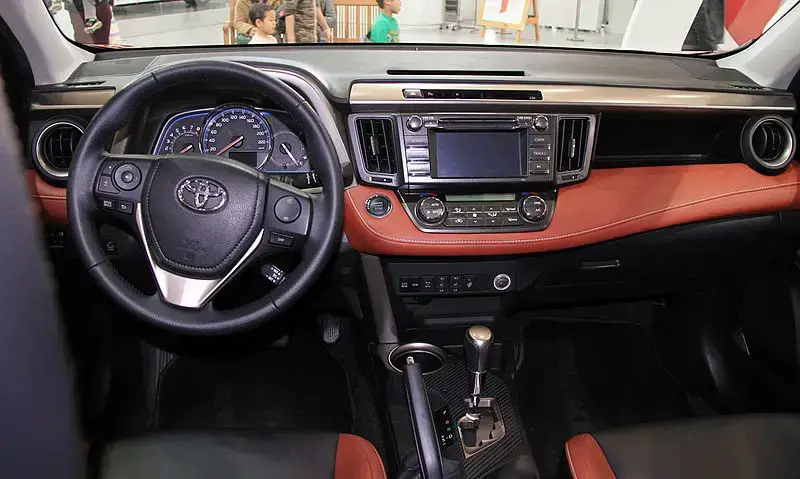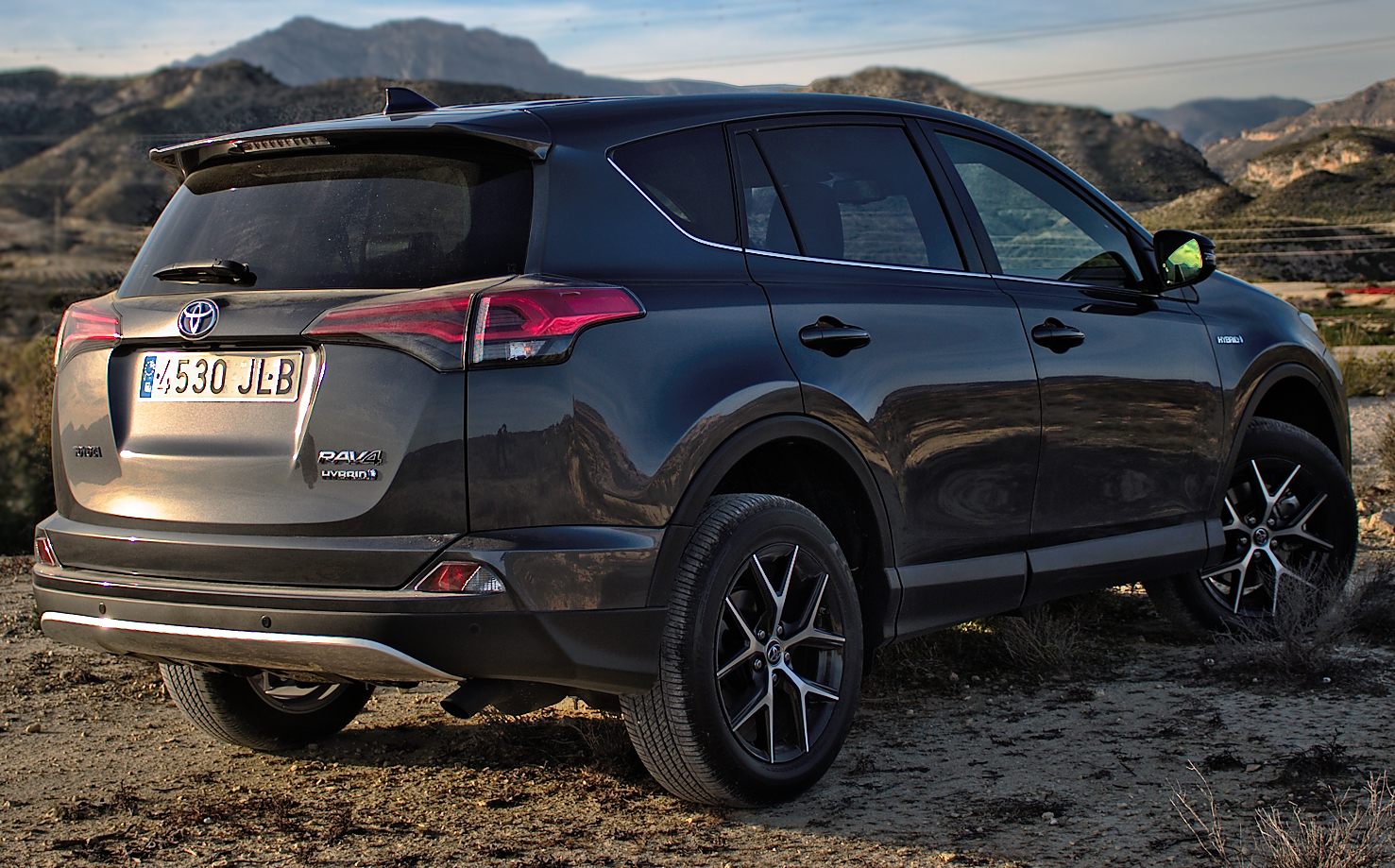Review: Toyota Rav4 XA40 ( 2013 – 2018 )

If the previous generation was a car for the ladies who wanted to show you exactly who’s the boss, the Toyota Rav4 XA40 was an instant hit with everyone from chefs to taxi drivers. Here’s how the Toyota Rav4 XA40 managed to grab a slice of the modern car pie, in today’s review.
The folks at Toyota have realized since the previous generation that most customers will never take their cars off-roading. Most customers buy them because they look sort imposing, offer that higher driving position which allows you to look down on the rest of the traffic, and have the ability to climb kerbs and handle with ease modest to medium snowfalls. And all of that in a much more affordable package than the full size, proper SUV.
What they’ve realized however with the 4th generation Rav4 is that most customers won’t even go out of town and aren’t as passionate about that active lifestyle Toyota aggressively promoted in the ads when it launched.
What does the new 2013 Toyota Rav4 bring to the table?
- First of all, it comes wit a fresh look, so fresh that you can easily serve it at Alfresco Fusion Bar on Hall Green. If Toyota used to appeal to people with WW2 War Veteran ID cards, the Toyota Rav4 XA40 comes with looks to lure the youth to this conservative brand. Personally, I think they’ve succeeded.
- The Japanese are not good with diesel engines. It makes sense, too, because a diesel engine has little use in crowded Japan. So they decided to replace their old base engine, the famous 2.0 D-4D, with one from BMW, borrowing the N47 engine and adding a dash of sushi and questionable “chinese cartoons”.
- Out with the old off-road style boot door construction and back to a conventional hatchback style boot. You finally have a usable spare tire and you can finally open the boot even if you’re not Jay Cutler.

Toyota Rav4 XA40 engines
Petrol
- 2.0 3ZR-FAE of 151 horseppwer – The same Toyota workhorse we’ve become accustomed to, this engine is honorably living up to somewhere around 300,000km. Occasionally it breaks down the water pump and later in life develops an addiction for. Kind of how Hank Hill develops an addiction to Alamo Beer.
- 2.5 2AR-FE of 178 horsepower – The myth of Japanese petrol engine quality is upheld by this engine. More fantastic than the world Barbie’s living in, this naturally aspirated petrol is one of the few trouble-free engines, except for the occasional water pump issue. A great engine, but one we won’t buy because it’s not a diesel and it’s not a VW. It was however a real hit in the USA and Canada, as this was the largest petrol available, with the 3.5 V6 being retired from the Rav4.
Diesel
- 2.0 2WW of 122 horsepower – Unfortunately the Japanese are not very good at this whole diesel engine thing, so they took the GM route and bought engines from the Germans (as GM bought from the eye-talians). Unfortunately for them, they didn’t really do their homework properly and bought the 2.0 liter N47 engine from BMW, an engine that would have been more reliable if it had been built from clay and the self-esteem of a high school freshman. Even though the timing chain issues should theoretically be fixed, this foster child is below the level of traditional Japanese diesels in terms of reliability.
- 2.2 2AD-FTV and 2AD-FHV of 150 horsepower – Gone are the days when the headgasket that was firing up faster than a college student after 5 beers, leaving you only with issues on the injector and particle filter side. These engines are totally unsuitable for urban driving so think carefully before buying. Mixt driving styles are manageable by this engine however so you’re good.
Hybrid
2.5 2AR-FXE hybrid of 197 horsepower – Basically the same 2AR-FE 2.5 petrol engine, modified to run on Atkinson cycle. Aided by an electric motor, the hybrid version of the Toyota Rav4 XA40 is the best powertrain and most balanced in terms of performance-cost. Naturally, I’m not talking about money here because I don’t have any, but a Toyota Rav4 XA40 hybrid is comparable in price to the Audi Q3 and BMW X2, even if the size and features place it more of a rival to the Audi Q5 and BMW X3 or the classic VW Tiguan. But it doesn’t have the premium German badge everyone wants so it’s cheaper than the competition. Which is great.

Toyota Rav4 XA40 General issues
- As with the previous generation, the Toyota Rav4 XA40 might come without a spare wheel. Either you buy a spare, or you buy run-flat tires and lose comfort, or you feel lucky and just drive with no spare wheel. In retrospect however, I doubt that most Rav4 users know or care how to change a tire. They just call the AA. Because that’s mostly the only thing you’re gonna call the AA for, when you have a Rav4.
- Diesel engines are very sensitive to urban driving, as the particle filter and EGR clog up immediately. This is a common issue with Japanese cars, so consider a petrol model if you plan to drive mainly around town.
- The infotainment system on the Toyota Rav4 XA40 is more lost than I am when browsing TikTok. A lot of people complain about its quality, so it’s good to have a GPS or phone with you at all times. Of course, those won’t help you when you go to the UK wilderness up north, because there you go back in time and transcend the geographical plane.

Toyota Rav4 XA40 Verdict
A lot of people considered the Toyota Rav4 XA40 as the best thing since Mory Kante. I could understand this because the Rav4 has remained a reliable and cheap car for what it offers. It’s no longer that legendary compact SUV that launched the cross-over concept, but most owners will never leave the tarmac anyway. The most intense off-road they’ll be doing drive over a puddle and up an incline somewhere in a field. You don’t need self-locking differentials for that. So the Toyota Rav4 XA40 remains a car tailored for the target audience, a much wider audience this time than 50 lbs-fur-coat-wearing speak-to-the-manager indoor-sunglasses lady. It’s a proper car that appeals to anyone who wants a versatile, reliable, and relatively cheap car.
Which engine do I recommend? For diesel, I recommend the 150 horsepower 2.2 engine, and for petrol I highly recommend the fabulous 2.5 petrol + electric hybrid with a total output of 197 horsepower.
Similar Articles

Review : Skoda CitiGO ( 2011 - 2020 )

Review : Seat Mii ( 2011 - 2020 )

Review : VW Up! ( 2011 - 2023 )
Write an answer
- Review : Skoda CitiGO ( 2011 - 2020 ) 02 August 2025
- Review : Seat Mii ( 2011 - 2020 ) 02 August 2025
- Review : VW Up! ( 2011 - 2023 ) 16 July 2025
- November 2025
- October 2025
- August 2025
- July 2025
- April 2025
- March 2025
- February 2025
- January 2025
- December 2024
- November 2024
- October 2024
- August 2024
- July 2024
- June 2024
- May 2024
- April 2024
- March 2024
- February 2024
- January 2024
- December 2023
- November 2023
- October 2023
- September 2023
- August 2023
- July 2023
- June 2023
- May 2023
- April 2023
- March 2023
- February 2023
- January 2023
- December 2022
- November 2022
- October 2022
- September 2022
- August 2022
- July 2022
- June 2022
- May 2022
- March 2022
- April 2021
- January 2021
- December 2020
- November 2020
- October 2020
- September 2020
- August 2020
- July 2020
- March 2020